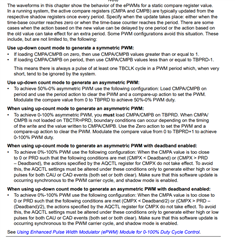Dear TI Experts,
Background:
I am attempting to generate a pulse-skipping scenario by symmetrically enabling and disabling the ePWMA and ePWMB outputs.
ePWM Setup:
-
Counter Mode: Up-Down counting
-
TBPRD = 200
-
CMPA = 0 (Based on duty = 100%)
-
CMPA is loaded at Zero Event (
TBCTR == 0) -
Interrupt Source: CMPA match when TBCTR == CMPA while counting down
Query 1 : what happens when TBCTR == CMPA == ZERO (100% duty scenario)?
Assumption: The CMPA match event will be missed in this case, because at TBCTR == 0, the counter is transitioning from down-counting to up-counting. Therefore, the TBCTR == CMPA == ZERO match does not occur while TBCTR is in the down-count phase.
Is this assumption valid?
ePWM Setup:
-
Counter Mode: Up-Down counting
-
TBPRD = 200
-
CMPA = 200 (Based on duty 0%)
-
CMPA is loaded at Zero Event (
TBCTR == 0) -
Interrupt Source: CMPA match when TBCTR == CMPA while counting up
Query 2: What happens when TBCTR == CMPA == TBPRD (0% duty scenario)?
Assumption: The CMPA match event will be missed because at TBCTR == CMPA == TBPRD, the counter reverses direction and starts counting down. Therefore, the TBCTR == CMPA condition does not occur while counting up.
Is this understanding, correct?



